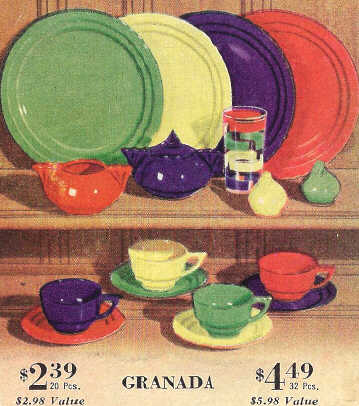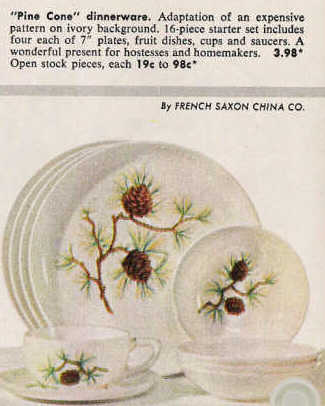|
In 1929, the Saxon China Company of Sebring, Ohio joined with a group of potteries to form the American Chinaware Corporation. Unfortunately, the joint effort did not last beyond 1931 and Saxon China, like several other firms, closed their doors. (See this page for more on the American Chinaware Corporatoin.)
In 1934, William Vern Oliver (1890-1963) purchased the Saxon plant and renamed it the French Saxon China Company. According to the article "The Men Behind French Saxon" by Howard Von Elling (China, Glass and Decorative Accessories, Dec. 1946) , Oliver and sales rep Duncan G. Curtis were the two driving forces in getting the pottery off the ground. When Curtis took samples to New York he started on a very small scale with modest displays. Eventually, he was able to get some exclusive decals from suppliers and business started to grow.
The trade journal, China, Glass and Lamps wrote about French Saxon's upgrades in their July 1939 issue:
Work has been started on further modernization of the pottery of the French Saxon China Co. at Sebring, Ohio, manufacturers of dinnerware and kitchenware. The improvements will include construction of a large, circular bisque kiln and installation of automatic brushing and dipping machinery. It is expected the improvements will be completed by September 1.
Since the old Saxon pottery was taken over late in 1934 by W. V. Oliver and associates under the name of French Saxon China Co., the productive equipment of the pottery has been changed completely. In addition to the new continuous kiln for bisque ware, there has been installed in recent years a continuous decorating kiln and a circular, continuous glost kiln. With the new equipment, capacity of the plant will be increased from 4,500 dozen per day to 7,000 dozen.
After W. V. Oliver died in 1963, Royal China purchased French Saxon. In East Liverpool, Ohio's The Evening Review from March 7, 1964, the following announcement ran:
Miss Beatirce L. Miller, president of Royal China, Inc., today announced acquisition of all facilites of the French Saxon Pottery Co. at Sebring.
The purchase agreement was concluded late Friday.
She added she plans to operate the firm as a separate corporation to be an affiliate of Royal China, which also operates a division here and a plant known as Royalon at Longansport, Ind.
She plans limited production schedules that will make immediate use of the French Saxon warehouse.
"This expansion move by Royal China is an expression of our faith in the American dinnerware industry where new techniques and production processes make us competitive from the standpoint of both quality and price," she asserted.
The officials of Royal said there would be no immediate effect on operations of the plant here.
In December 1969, Jeannette Glass purchased Royal China and its subsidiaries which included French Saxon. On February 16, 1970, a plant fire did considerable damage at Royal China. One fireman, Selwyn Trainer, lost his life fighting the blaze. According to The Salem News of Salem, Ohio, dated February 17, 1970:
Mark B. Silverberg, president of Royal China, said last night that production activities of the burned-out plant will be transferred to the French Saxon Pottery Co. in Sebring, which the firm also owns.
He added that the kilns at French Saxon will be started immediately and that 75 percent production can be attained within two weeks.
Plans were made to rebuild Royal China with modern equipment. Rather than build compeltely new, Jeannette Glass decided to simply expand the already existing French Saxon plant. By February 1972, the work was almost complete. It was during this time that Jeannette Glass planned on gradually phasing out production at another one of their holdings, Harker Pottery in Chester, West Virginia.
French Saxon produced both solid colored and patterned semi-vitreous dinnerware. They made two solid colored dinnerware lines using the Zephyr shape. Romany used Fiesta like colors: Nile green, tangerine, navy blue, maize (yellow), turquoise, and black. When carried by Sears, Romany was called Granada. The second line, Rancho, was made up of typical '50s colors such as gray, chartreuse, dark green, yellow, and burgundy.
One of French Saxon's most collectible lines is Pine Cone which was carried by Woolworth's five and dime stores.

Granada for Sears

Pine Cone for Woolworths |
|
|